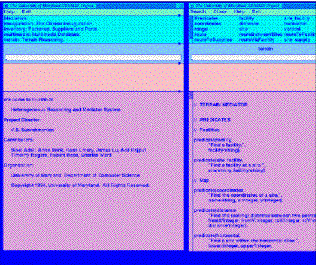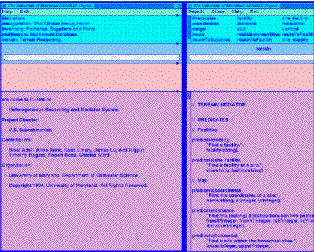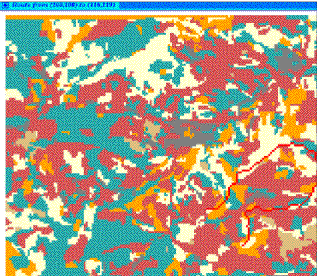3.1. Case Study: Integrating Terrain Maps, Relational Databases, and Planning
In this section, we will describe an application of our work to intelligent terrain reasoning that involves integrating terrain map data, relational data, and planning packages (developed at the US Army Corps of Engineers). The purpose of such an integrated system is many-fold. It can be used as a basis for vehicular navigation in disaster relief situations (e.g. floods, earthquakes, volcanic disasters, etc.), as well as in military mission planning applications. In these applications, a user, who may either be a human or may be an autonomous vehicle, may be interested in posing queries of the following types:
- (Unknown Destination) Given a location, find a place that has an airfield as well as certain types of ammunition. Presumably these resources are needed in order for the autonomous/manned vehicle to satisfy its mission.
- (Route Properties) Furthermore, no point in the route may be less than 4 miles from an enemy outpost. In this example, in addition to the fact that the destination is unknown, we have the fact that the query asks not only for a route to this unknown destination point, but it asks for a route that satisfies certain desiderata, i.e. which satisfies certain conditions that require accessing external databases (e.g. to figure out where enemy outposts lie).
A route planner (which we will call RP) has been implemented at the US Army Topographic and Engineering Center. Given two points, this route planner will find an optimal, least-cost path between these two points (if one exists). Thus, for instance, the query
RP:route((35,70), (200,98))
returns the set of least-cost paths from the origin point, (35,70) to the destination point (200,98) that are found by the Army's route planner.
We illustrate how this example may be solved within the HERMES framework, using RP as a domain. For this, let us suppose that we have a relational (PARADOX) database containing a relation called facilities having the schema (Name,Facility). Thus, this relation may contain a tuple of the form (awasa,airport) denoting that the place, Awasa, has an airport. Other tuples in the relation facilities may be similarly interpreted. Suppose there is another (DBASE) database containing a relation called supplies having the schema (Place,Item) -- an example tuple in this relation is (awasa,gas) specifying that gas is available at Awasa (In practice, these relations will contain much more detail, but we keep them simple here in order to facilitate presentation.).
Using HERMES, we have integrated the following four domains -- RP, DBASE, and PARADOX -- along with a spatial database that identifies points (xy-coordinates with place names). We have written a mediator that may be used to solve this example using the rule given below.
Query 1: Let rte1 be a ternary predicate such that rte1(O,D,R) is satisfied iff R is a route from the origin to an unspecified destination such that the destination has an airfield as well as certain types of ammunition. For this, we may define the following clause in the mediator:
- rte1(O,D,R) <-
- in(P1,PARADOX:select=(facilities,facility,``airfield'')) &
in(P2,DBASE:select=(supplies,item,``ammunition'')) &
=(P1.place,P2.place) &
in(D,SPATIAL:findpt(P1.place)) &
in(R,rp:route(O,D)).
To obtained the result from a given location l, we can pose the query
<- rte1(l,D,R).
This is then processed as follows: PARADOX is invoked which SELECTs all tuples from the facilities relation that have the an airfield facility. P1 is then instantiated to one of the selected tuples. Next DBASE is then queried to SELECT all tuples from the supplies relation that have the item field set to ammunition. P2 is instantiated to one such tuple. A check is made to see that P1 and P2 have the same place field. In other words, this ensures that single place is found with both ammunition and an airfield? If not, the HERMES inference engine looks for other possible instantiations of P1 and P2 that satisfy these constraints. Finally, the xy-location of the place P1.place is computed using the spatial domain, instantiating D, and RP is called to find a route from the origin l to D.
Solving the second query is somewhat more complicated because of the additional requirement that no enemy outpost lies within 4 miles of any point on the route. Let us suppose that the SPATIAL domain contained in our solution to Query 1 above has a special function called range that takes a point P and a radius Rad as inputs and returns all enemy outposts within Rad units of P.
Query 2: We define a new predicate called rte2 as follows.
rte2(O,D,R) <- rte1(O,D,R) & good(R).
good(nil) <-
good(cons(H,T)) <- goodpoint(H) & good(T)
goodpoint(H) <- is({},spatial:range(H,4)).
Note the use of the special HERMES predicate ${\tt is}$ described earlier.
We have also been developing a mediator in HERMES for law enforcement
applications. The general problem is best illustrated with an
example. Consider the problem of identifying all people P who have
been recorded, by surveillance cameras, as having met with an
individual X (for instance, X may be a Mafia chief like Don
Corleone), who live within a hundred mile radius of Washington DC, and
who work for a suspected front company ``ABC Corp.'' Solving this
problem may require access to a wide variety of data sources
and furthermore, require recourse to diverse
reasoning paradigms as well. For example, it may be necessary to
We define the following three mediating rules.
The seenwith predicate access a domain called
faceextract that we assume is a pattern recognition package, and that
it uses the function segmentface to locate the faces in a set of
photographs. The output of the function contain mugshots that can be
stored. The extraction procedure returns a list of pairs of the form
(<resultfile,origin>) specifying which image in the
surveillance data, a given face was extracted from (the origin) and
where the mugshot is now stored. The faceextract domain also
contains a function called matchface that takes a face (such as
those extracted by the faceextract domain) and checks if this
face is identical to another face in the mugshot library. Likewise,
the seenwith predicate access a domain called facedb
containing a function called findface which determines, given a
person's name, whether his or her face is in a mugshot library. The
facedb domain also contains a function called findname
which, given a mugshot in the mugshot library, returns the name of the
person involved.
Given that a person Y has been seenwith X,
swlndc (for ``seen with and lives near DC''), accesses a relational
database to find the address of Y, and then accesses a spatial
data management system to determine what (x,y) coordinates, on
a map of the DC area, this address corresponds to (using a function
called locateaddress). It then determines, using a function
called range, whether this address lies within the specified
distance from DC.
Finally, a person Y is a suspect just in case
swlndc(``Don Corleone'',Y) is true and if he is an employee of
``ABC Corp.'' For this, a DBASE relation called empl_abc is
accessed. The above three clauses express the mediator for this
example in its entirety (though the individual domains are not
completely shown).
When the user brings up HERMES under Unix, the
first screen shown in Figure 4,
appears. The top window in this screen contains a list of available
mediators. The user may select a mediator by clicking on it with the
mouse button. To select the terrain mediator,
the user clicks on terrain. The second
screen in Figure 4 shows the screen that
results -- the top screen contains various predicates defined within the
terrain mediator. The buttons in the command bar at the top are suitably
modified as well. The bottom window brings up a description of the mediator.
The user may scroll through either the top window or the bottom window by
using the scroll bar on the left. If the user wishes to find help
information on a particular predicate, then s/he may click on that predicate
with the mouse button.
The first screen
in Figure 5 shows the result of clicking on
the routeToFacility predicate. At this stage, the second window
from the bottom shows the usage of the predicate
routeToFacility together with a help string explaining the utility
of the predicate. The figure shows the screen after the user has keyed
in a specific query
The new screen that pops up with the answer is shown in the
second screen of Figure 5,
The second window from the bottom contains the desired solution. Also
observe that the top window now contains the statement
indicating that the file 2.scr is available for viewing. This is
a script file. If the user wishes to view this file, then he may click
on it -- doing so generates a pictorial version of the actual path
generated (see Figure 6 where the red path denotes the desired
route to the facility in question. In general, the files shown in
response to a user query may themselves be heterogeneous files such
as .GIF files of .SCR files, plain text files,
or hypermedia documents. The display of these files requires the use of
the action module to ``bring up'' the files in the desired format.
Following Wiederhold's pioneering paper on mediators [24,25],
there have been several efforts to
develop general-purpose methods of integrating multiple databases.
In contrast to approaches that specifically deal with integrating
multiple databases, we emphasize that our system and framework are
applicable to the integration, not only of multiple
databases, but also to the integration of multiple software
packages (e.g. spreadsheets), and also multiple reasoning paradigms
(e.g. path planning, face recognition, terrain reasoning, etc.).
Multidatabases and federated databases form a well-known family of
database integration paradigms. In such frameworks, an attempt is
made to create a ``global'' integrated scheme from a number of local
schema -- then the global schema is queried. Most of the works in
this arena are used to integrate multiple relational databases
(and in some cases, object oriented databases), identifying schema
mismatches, and eliminating them as part of the query processing
procedures. Some elegant pieces of work on multidatabases are those
due to Litwin et. al. [6,13,14]. In addition,
Krishnamurthy, Litwin and Kent [11] define criteria that a
language that a language that integrates multiple databases must
satisfy. They show how to handle schematic discrepancies.
Intuitively, two databases may contain the semantic information, but
this information may be represented in different ways (e.g. in one
database, all the information may be contained in one relation, while
in the other, the same information may be spread over two relations).
They define a query language that takes such schematic mismatches into
account when handling queries. In a similar vein, Spaccapietra and
Parent [21] structural conflicts that arise when multiple
databases contain similar, but structurally different data. They show
how data across multiple databases can be ``linked'' or ``tied
together'' based on common attribute values (even though the attribute
names may be different across different databases). Similarly, Bright
et. al. [5] and Sciore et. al. [18] develop an array
of methods to automatically resolve (using different techniques)
semantic conflicts in multidatabases. Their work can be used to
contribute to the conflict resolution toolkit that forms part of the
HERMES architecture.
Generally speaking, the HERMES system applies to a wide diversity of
domains with very different aspects to them such as the path planning
domain, the face recognition domain, etc., that are not handled by
multidatabases. As such, the types of software packages and the kinds
of reasoning performed in systems like HERMES are broader than those
in multidatabases. Other recent efforts that are proceeding synchronously
with ours, are the SIMS/LOOM effort at ISI [2] and efforts to
develop a language called KQML [12]. SIMS is a system that uses
an object-oriented language called LOOM to integrate information from
multiple databases. Objects in the world are classified into classes
and a set of relations that link objects and classes are also stored.
Various types of inheritance properties can be expressed in LOOM. Both
HERMES and SIMS can benefit from one another in a variety of ways -- for
instance, HERMES' generalized domain integration method is applicable
to the SIMS model as well. As mentioned, in our Heterogeneous User Interface,
the LOOM query language could form an important component therein, allowing
users who prefer LOOM's LISP-flavored syntax to express their queries in it.
KQML, in contrast, provides a method for communication requests to be
made between a mediator and various software packages. Various
KQML primitives like ask-if, ask-all,
etc. may be used to manipulate belief-states that an agent may have
(for example, this agent may a communications module that controls a
communication channel). HERMES could benefit from KQML by using
KQML agents in order to effect
communications across the network.
In contrast, KQML could benefit from HERMES by using HERMES' query language to
identify and extract relevant information from different data sources,
pool them together after identifying/resolving conflicts.
We see rich potential interactions with
both SIMS and KQML/LOOM.
[ Top ]
[ Previous Section ]
[ Next Section ]
3.2. Case Study: Face Recognition for Law Enforcement Applications
in(P2,facextract:segmentface('surveillancedata')) &
=(P1.origin,P2.origin) &
P1 <> P2 &
in(P3,facedb:findface(X)) &
in(true,facextract:matchface(P1,P3)) &
in(Y,facedb:findname(P3)).
in(A,PARADOX:select_eq('phonebook',"name",X)) &
in(Pt1,SPATIAL:locateaddress(A.streetnum,A.streetname,A.cityname)
&
A.statename, A.zipcode)) &
in(true,SPATIAL:range('dcareamap',Pt1.X,Pt2.X,100)).
in(Tuple,DBASE:select_eq('empl_abc',"name",Y)).
3.3. System Usage

Figure 4. HERMES: Mediator Selection and Predicate Listing Screens

Figure 5. HERMES: Query Articulation Screen and Screen after Query Execution
routeToFacility(100,100,50,F,RC,RL,R,S):1.
Files : 2.scr

Figure 6. HERMES: Screen after Action Module's Intervention
3.4. Related Work
 Click here to go back to the Hermes homepage .
Click here to go back to the Hermes homepage .